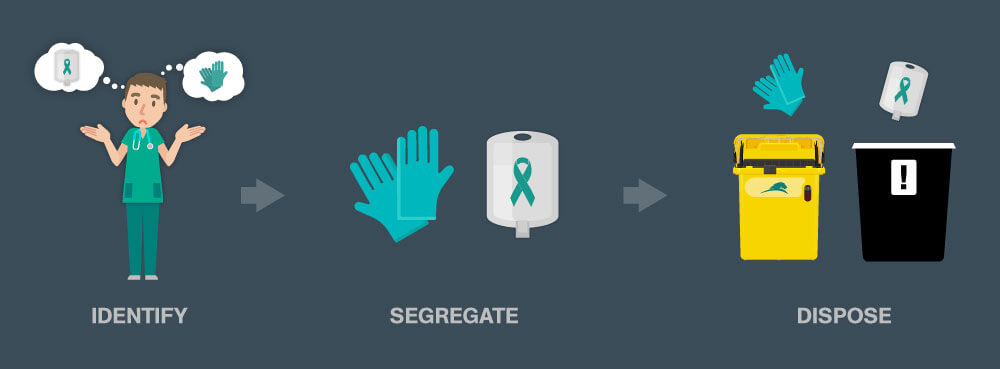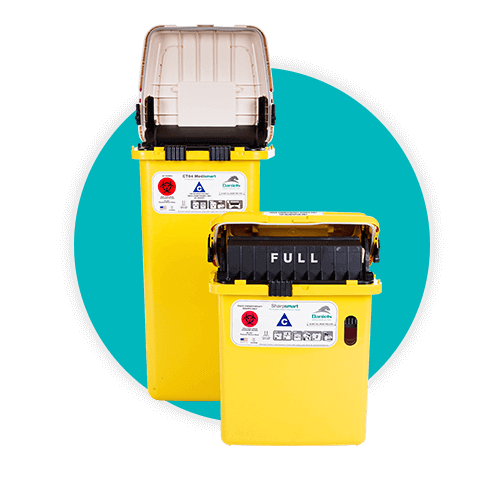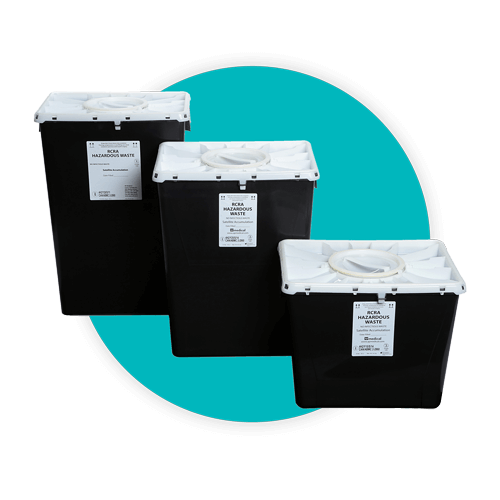Steps to Ensure Proper Disposal of Chemotherapy Waste

It is critical to know the specific requirements for handing chemotherapy waste disposal, including guidelines covering identification, segregation, and compliant disposal. These guidelines are applicable for hospitals, pharmacies, and outpatient centers, or in other words, any healthcare provider dealing with such products. However, be aware that state guidelines can be more detailed and strict in regard to disposal processes than federal guidelines. Here’s what you need to know to ensure compliance.
TOPICS WE WILL COVER:
1 / Who makes the rules for chemotherapy waste and disposal practices?
4 / Tips to follow compliant chemotherapy waste disposal practices
5 / Turn to Daniels Health for chemotherapy waste disposal
Who makes the rules for chemotherapy waste and disposal practices?
Chemotherapy waste and drugs associated with chemotherapy practices are typically hazardous in nature, although not all chemotherapy drugs or their waste guidelines are equal. As a hazardous waste, the primary authorities of chemotherapy waste disposal processes include federal and state-level governmental agencies.
The Resource Conservation and Recovery Act (RCRA) is the first place to look when trying to understand the categorization of chemotherapy drugs. There you can find an updated list of hazardous pharmaceuticals within the P-list and U-listing of chemical products and/or substances.
Chemotherapy drugs are also known as antineoplastics. Common chemotherapy drugs are found under the U-listings, which are hazardous wastes that typically come from discarded, commercially used chemical products. The Environmental Protection Agency (EPA) states that it is mandatory that chemotherapy waste be considered a hazardous waste.
For more details of drug lists that are classified as hazardous (and their resulting wastes), turn to the National Institute for Occupational Safety and Health (NIOSH) Antineoplastic and Other Hazardous Drugs in Healthcare Settings, provided by the Centers for Disease Control and Prevention.
It's important to note that disposal requirements will change depending on whether the waste is classified as “Trace chemotherapy waste” or “Bulk chemotherapy waste.” In your facility, every employee should be knowledgeable enough to discern the difference between trace and bulk chemotherapy waste, as each comes with their own guidelines for disposal.
Trace chemotherapy waste

Trace chemotherapy waste is typically generated during a chemotherapy treatment process through the use of IV tubes, vials of medicine, IV bags, or equipment or tools that deliver the chemotherapy drugs to a patient. It is defined as vials or other containers that have less than 3% of the original contents by weight, after removing as much of the chemotherapy medicine as feasible and by normal means. Trace chemo waste also includes personal protective equipment (PPE), towels, wipes, or bedding that has been soiled with a chemotherapy drug.
Trace chemotherapy waste is also often known as an “RCRA empty” since it comprises any empty chemotherapy containers, intravenous bags/bottles and IV tubing that do not hold either a P-listed chemotherapy medicine or a State-only hazardous waste. This type of chemotherapy waste can be disposed of using a Chemosmart container.
Bulk chemotherapy waste
A “bulk” chemotherapy waste, by contrast, is defined as chemo waste that exceeds 3% of the original contents by volume and is considered a RCRA hazardous waste. This includes:
- Any non-empty containers of chemotherapy medicine, including IV bags, bottles and tubing.
- Chemotherapy waste that is designated as RCRA hazardous waste or State-only dangerous waste.
- All containers or IV bags and tubing once containing a P-Listed RCRA material, including Arsenic Trioxide.
- Any materials used to clean up a chemotherapy spill.
This type of waste must be disposed of following all applicable procedures for hazardous waste.
Tips to follow compliant chemotherapy waste disposal practices
Daniels Health offers tips for chemotherapy waste disposal practices that help to ensure compliance.
- Never mix healthcare waste streams. This is vital for any healthcare provider and facility. Even if you’re an oncology center, take steps to segregate the types of chemotherapy waste produced by your facility defined under federal and state guidelines.
- Federal guidelines say incinerate! Only approved waste collectors are allowed to transport and dispose of chemotherapy waste. (The responsibility for ensuring proper licensing, certification, and approval by state or local governmental agencies are applicable to the waste provider you use. The cradle-to-grave approach means that it is your responsibility (the waste generator) to ensure that all waste is properly disposed of, from its point of origin to its final disposal.
- Follow labeling regulations. The placement and size of the labels may differentiate among states. The labeling requirements are not only applicable to the segregation and storage of waste in a healthcare facility prior to transportation or disposal, but during the transportation process, of which several governmental agencies are involved. Such agencies include the Environmental Protection Agency, the Drug Enforcement Agency, and federal and state Departments of Transportation.
- Read and understand Code of Federal Regulations Title 40 (Protection of the Environment) found in §261.7 - Residues of Hazardous Waste and Empty Containers. This is especially important when it comes to trace chemotherapy waste and the definition of “empty” for trace elements that remain in any container.
-
Know the criteria for listing hazardous wastes. Also found under Title 40 (§216.11) solid hazardous wastes meet certain standards such as the nature of their toxicity, the concentration of their constituents, and the potential for toxic degradation of that substance to damage the environment due to improper management, and others.
Turn to Daniels Health for chemotherapy waste disposal
Daniels Health has over three decades of experience when it comes to medical waste management processes and provides resources, products, and services for chemotherapy waste disposal. We encourage and guide our clients toward compliant, safe, and cost-effective services for all waste streams. For more details regarding chemo waste disposal services, call us today.
